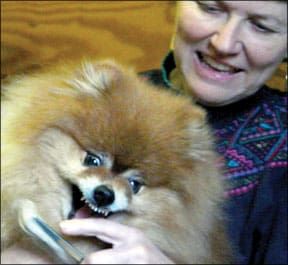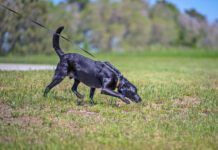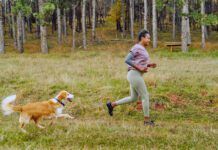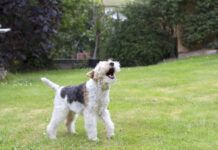BITE INHIBITION: OVERVIEW
- Take the time to teach your puppy the invaluable skill of inhibiting his bite. It could be one of the most important lessons he learns – one that will serve him well for a lifetime.
- Supervise children with your puppy so your puppy doesn’t get reinforced for inappropriate biting, and so your children don’t have to suffer the pain of uninhibited puppy mouthing.
- Resist the pressure from some members of the dog community to use pain and force to suppress your puppy’s biting behavior. You know there’s a better way.
My dog bites me. A lot. Scooter, the 10-pound Pomeranian we adopted from the shelter after he failed a behavior assessment (for serious resource-guarding), has bitten me more times than I can count. Most of the time I don’t even feel his teeth. He has never broken skin, and the few times I have felt any pressure, it’s been because I’ve persisted in what I was doing despite his clear request to stop. Scooter has excellent bite inhibition.

In the dog training world, bite inhibition is defined as a dog’s ability to control the pressure of his mouth when biting, to cause little or no damage to the subject of the bite. We know that all dogs have the potential to bite, given the wrong set of circumstances. Some dogs readily bite with little apparent provocation, but even the most saintly dog, in pain, or under great stress, can be induced to bite. When a bite happens, whether frequently or rarely, bite inhibition is what makes the difference between a moment of stunned silence and a trip to the nearest emergency room for the victim (and perhaps the euthanasia room for the dog).
A bite is at the far end of a long line of behaviors a dog uses to communicate displeasure or discomfort. To stop another dog, human, or other animal from doing what he perceives to be an inappropriate or threatening behavior, the dog often starts with body tension, hard eye contact, a freeze, pulling forward of the commissure (corners of the lips). These “please stop!” behaviors may escalate to include a growl, snarl (showing teeth), offensive barking, an air-snap (not making contact), and finally, an actual bite. The dog who does any or all of these things is saying, “Please don’t make me hurt you!”
Some foolish humans punish their dogs for these important canine communications. “Bad dog, how dare you growl at my child!” Punishing your dog for these warning signals can make him suppress them; he’ll learn it’s not safe to let you know he’s not comfortable with what you’re doing -and then bites can happen without warning. (See “Understand Why Your Dog Growls,” October 2005.)
Others ignore the signals and proceed with whatever was making the dog uncomfortable. This is also foolish, because it can prompt the dog to express his feelings more strongly, with a less inhibited bite that might break skin and do damage.
The wise dog owner recognizes the dog’s early signals, and takes steps to reduce or remove the stimulus that is causing the dog to be tense, to avoid having her dog escalate to a bite. She then manages the environment to prevent the dog from constant exposure to the stressful stimulus, and modifies her dog’s behavior to help him become comfortable with it. Sometimes, however, even the best efforts of the wisest dog owners can’t prevent a bite from happening. If and when it does, one hopes and prays that the dog has good bite inhibition.
Installing Bite Inhibition
In the best of all worlds, puppies initially learn bite inhibition while still with their mom and littermates, through negative punishment: the pup’s behavior makes a good thing go away. If a pup bites too hard while nursing, the milk bar is likely to get up and leave. Pups learn to use their teeth softly, if at all, if they want the good stuff to keep coming. As pups begin to play with each other, negative punishment also plays a role in bite inhibition. If you bite your playmate too hard, he’ll likely quit the game and leave.
For these reasons, orphan and singleton pups (as well as those who are removed from their litters too early) are more likely to have a “hard bite” (lack of bite inhibition) than pups who have appropriate interactions for at least seven to eight weeks with their mother and siblings. These dogs miss out on important opportunities to learn the consequences of biting too hard; they also fail to develop “tolerance for frustration,” since they don’t have to compete with littermates for resources. They may also be quicker to anger -and to bite without bite inhibition -if their desires are thwarted. Note: Being raised with their litter doesn’t guarantee good bite inhibition; some dogs have a genetic propensity to find hard biting (and its consequences) to be reinforcing; others may have had opportunity to practice and be reinforced for biting hard.
Your dog may never bite you in anger, but if he doesn’t have good bite inhibition you’re still likely to feel a hard bite when he takes treats from your fingers -and removes skin as well as the tasty tidbit.
If you find yourself with a puppy who, for whatever reason, tends to bite down harder than he should with those needle-sharp puppy teeth, you need to start convincing him that self-restraint is a desirable quality. You can’t start this lesson too early when it comes to putting canine teeth on human skin and clothes. Ideally, you want to teach your pup not to exert pressure when mouthing by the time he’s five months old, just as his adult canine teeth are coming in, and before he develops adult-dog jaw strength. Here are the four R’s of how to do it:
1. Remove
When your puppy bites hard enough to cause you pain, say “Ouch!” in a calm voice, gently remove your body part from his mouth, and take your attention away from him for two to five seconds. You’re using negative punishment, just like the pup’s mom and littermates. If he continues to grab at you when you remove your attention, put yourself on the other side of a baby gate or exercise pen. When he is calm, re-engage with him.
2. Repeat
Puppies (and adult dogs, and humans) learn through repetition. It will take time, and many repetitions of Step #1, for your pup to learn to voluntarily control the pressure of his bite. Puppies do have a very strong need to bite and chew, so at first you’ll “ouch and remove” only if he bites down hard enough to hurt you. Softer bites are acceptable -for now. If you try to stop all puppy biting at once, both of you will become frustrated. This is a “shaping” process (see “Fun Training Techniques Using Shaping,” March 2006).
At first, look for just a small decrease in the pressure of his teeth. When he voluntarily inhibits his bite a little -enough that it’s not hurting you -start doing the “ouch and remove” procedure for slightly softer bites, until you eventually shape him not to bite at all. By the time he’s eight months old he should have learned not to put his mouth on humans at all, unless you decide to teach him to mouth gently on cue.
3. Reinforce
Your pup wants good stuff to stick around. When he discovers that biting hard makes you (good stuff) go away, he’ll decrease the pressure of his bite and eventually stop biting hard. This works especially well if you remember to reinforce him with your attention when he bites gently. It works even better if you use a reward marker when he uses appropriate mouth pressure. Given that your hands are probably full of puppy at that particular moment, use a verbal marker followed by praise to let him know he’s doing well. Say “Yes!” to mark the soft-mouth moment, followed by “Good puppy!” praise to let him know he’s wonderful.
4. Redirect
You probably are well aware that there are times when your pup is calmer and softer, and times when he’s more aroused and more likely to bite hard.
It’s always a good idea to have soft toys handy to occupy your pup’s teeth when he’s in a persistent biting mood. If you know even before he makes contact with you that he’s in the mood for high-energy, hard biting, arm yourself with a few soft toys and offer them before he tries to maul your hands. If he’s already made contact, or you’re working on repetitions of Step #1, occasionally reinforce appropriate softer bites with a favorite squeaky toy play moment.
If there are children in the home with a mouthy puppy, it’s imperative that you arm them with soft toys and have toys easily available in every room of the house, so they can protect themselves by redirecting puppy teeth rather than running away and screaming -a game that most bitey pups find highly reinforcing.
It is possible to suppress a puppy’s hard biting by punishing him when he bites too hard. That might even seem like a quicker, easier way to get him to stop sinking his canine needles into your skin. However, by doing so, you haven’t taught him bite inhibition. If and when that moment comes where he really does feel compelled to bite someone, he’s likely to revert to his previous behavior and bite hard, rather than offering the inhibited bite you could have taught him.
Teaching Bite Inhibition to An Adult Dog
Teaching an adult dog to inhibit his bite is far more challenging than teaching a puppy. A dog easily reverts to a well-practiced, long-reinforced behavior in moments of high emotion, even if he’s learned to control his mouth pressure in calmer moments.
I know this all too well. Our Cardigan Corgi, now six years old, came to us at the age of six months with a wicked hard mouth. Hand-feeding her treats was a painful experience, and I implemented a variation of the “Ouch” procedure. Because she was biting hard for the treat rather than puppy-biting my flesh, I simply said “Ouch,” closed my hand tightly around the treat, and waited for her mouth to soften, then fed her the treat. Hard mouth made the treat disappear (negative punishment); soft mouth made the treat happen (positive reinforcement). She actually got the concept pretty quickly, and within a couple of weeks could thoughtfully and gently take even high value treats without eliciting an “Ouch.”
She still can take treats gently to this day, except when she’s stressed or excited; then she reverts to her previous hard-bite behavior. When that happens, I close the treat in my fist until she remembers to soften her mouth, at which time I open my hand and feed her the treat. So, while our bite inhibition work was useful for routine training and random daily treat delivery, if Lucy ever bites in a moment of stress, arousal, fear and/or anger, I have no illusions that she’s going to remember to inhibit her bite. Of course, I do my best to make sure that moment doesn’t happen.
Because I have more leeway with Scooter and his excellent bite inhibition, it’s tempting to be a little complacent with him. I try not to. One of Scooter’s “likely to bite” moments is grooming time. The poor guy has a horrible undercoat that mats, literally, in minutes. This is a highly undesirable Pomeranian coat characteristic. I could groom my first Pomeranian, Dusty, once a week without worrying about mats. I have to groom Scooter every night.
Of course he hates it; brushing always causes him some discomfort as I work to ease the tangles out without pulling too hard on his skin. We’ve made progress in the year we’ve had him; I can comb the top half of his body without encountering much resistance, but I can feel him tense up as I approach the more sensitive lower regions. Rather than relying on his good bite inhibition to get us through, I continue to use counter-conditioning and desensitization. I feed him treats (or have my husband Paul feed him) as I groom, or let him lick my hands (an activity he enjoys mightily -and one I can tolerate in place of his biting) while I comb out the tangles.
Whether you’ve taken the time to teach your puppy good bite inhibition or had the good fortune to inherit a dog who has it, don’t take it for granted. Continue to reinforce soft-mouth behavior for the rest of his life, and don’t be tempted to push the envelope of his tolerance just because you can. Even saints have limits.
What to NEVER Do if Your Dog Bites
Over the years, I’ve cringed at a variety of puppy-mouthing modification suggestions. Here are some of the things you don’t want to do:
Alpha-Rolls
Whole Dog Journal readers might think “no alpha-rolls” goes without saying by now, but I still see clients with mouthy puppies who have had their trainers, dog walkers, dog-owning friends, or veterinarians tell them to alpha-roll their bitey pups. Don’t do it. You are likely to elicit a whole lot more biting — truly aggressive biting — as your frightened pup tries to defend himself. (See “Puppies Who Demonstrate ‘Alpha’ Behavior,” WDJ July 2006.)
High-Pitched Yelps
This might surprise you. It’s often suggested by positive trainers, some of whom I respect greatly, but I don’t recommend it. The theory is that a high-pitched yelp makes you sound like a puppy in pain and communicates to your young dog in a language he understands.
The fallacy with this theory is that we think our feeble attempt to speak “puppy” with our human yelp might really communicate the same message as a real puppy yelp – like
trying to speak a foreign language by mimicking what we think the sounds are, without actually knowing any of the words. In my experience, the high-pitched yelp is as likely to incite an excited biting puppy to a higher level of arousal (and harder biting) as it is to tell him he bit too hard and should sofien his mouth. Don’t do it. A calm “Ouch!” sends a much more consistent, useful, and universal message, which is simply, “That behavior makes the good stuff go away.”
Hold the Dog’s Mouth Closed
Another classic bad idea. What self-respecting puppy wouldn’t struggle and try to bite harder with this inappropriate restraint? All the while, you’re giving your pup a bad association with your hands near his face, which isn’t going to help with grooming, tooth-brushing, mouth exams, or even petting. Don’t do it.
Push Your Fist Down His Throat
Seriously. For the same reasons as in the prior two suggestions, this is a really bad idea.
Don’t do it.
Push His Lip Under His Canine Tooth So He Bites Himself
There really is no end to the inappropriate ways people can think up to try to change behavior. This is another one that has a strong possibility of causing your pup to associate hands near his face with pain. Don’t do it.
Bite Your Puppy Back
Yep, some folks actually recommend this. I shouldn’t have to say this, but I will anyway: Don’t do it.
Pat Miller, CBCC-KA, CPDT-KA, is Whole Dog Journal’s Training Editor. Miller lives in Fairplay, Maryland, site of her Peaceable Paws training center.







I like what i read very uich. I have a serious question I had a lhsoapso that had no bit inhibition. whrn she would bite down on me I couldnt say ouch, because i was screaming in excruciating pain. When she let go of my hand I had bruises and tears on all my fingers. But i wonder f i was in more pain than the average peron, because i have tiny thin hands. If she was clamping harder wouldnt i have more damage
?